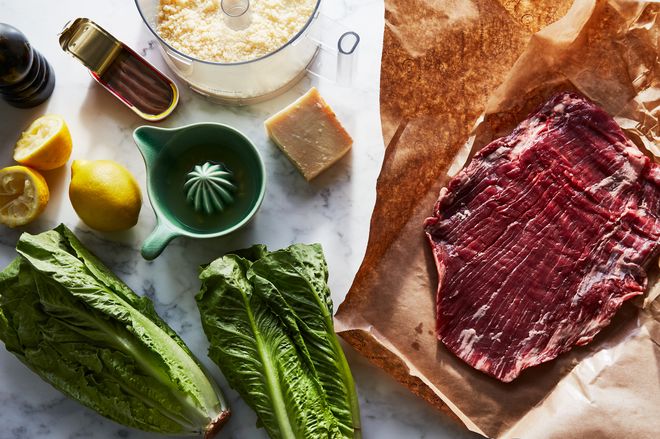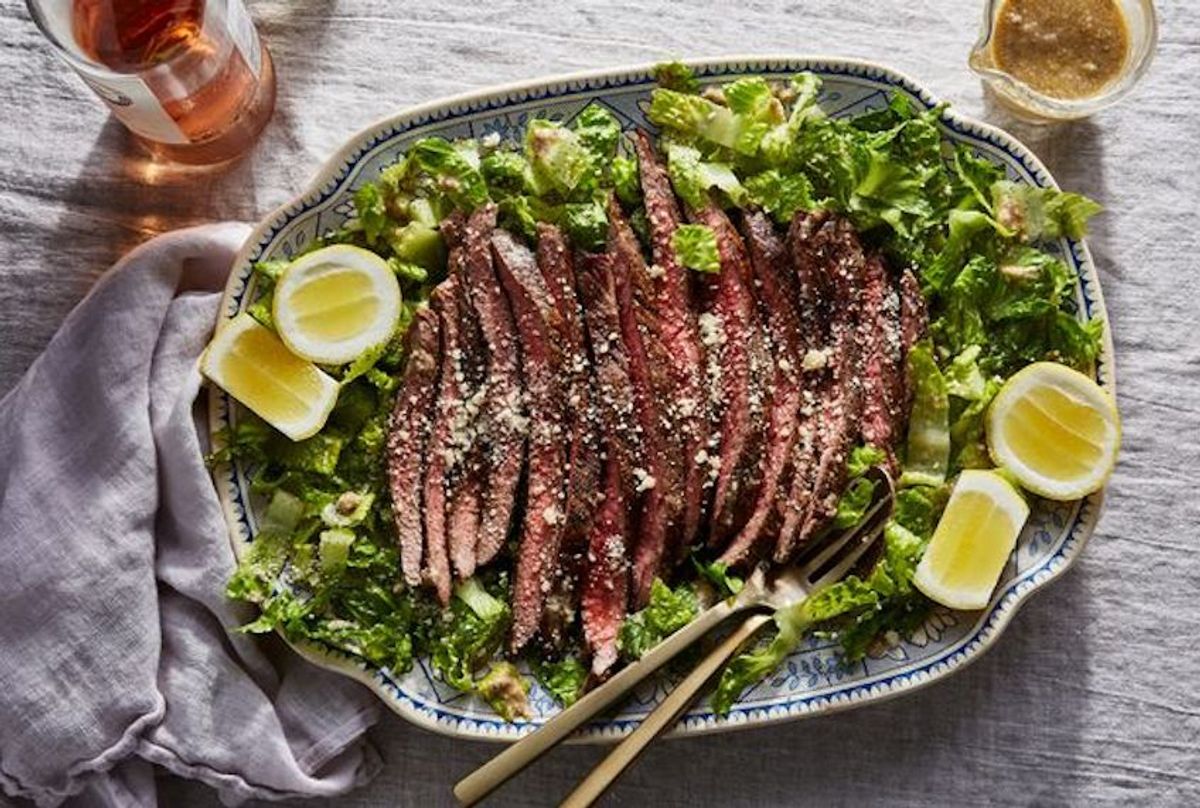Though these days it’s an old-school staple — on menus everywhere from Nancy Silverton’s Osteria Mozza to Macaroni Grill — Caesar salad is barely older than my grandmother, who, my family assures her, is still only 89 years young.
Like many food inventions, this one was supposedly a matter of necessity. In 1924, Caesar Cardini, an Italian chef who owned a popular-with-tourists restaurant in Tijuana, Mexico was short on ingredients. So he threw together a little of this and a little of that and — ta da! — Caesar salad was born.
The irony is: Caesar dressing isn’t the sort of dressing you make when you’re short on ingredients. Compared to most vinaigrettes — like this maple-Dijon one, this horseradish one, and this red wine one — Caesar is pretty long-winded.
Of course, the specifics change from recipe to recipe. But the usual suspects are: anchovies, garlic, Worcestershire sauce, lemon juice, Parmesan, Dijon mustard, egg yolk (or coddled egg or even mayo), and, if you’re my mother, capers.
The thing is, you don’t need all, or even most, of those ingredients to make a dressing taste like Caesar. While sources like "The New Food Lover’s Companion" summarize Caesar as a “garlic vinaigrette dressing,” if you ask me, garlic isn’t the make-or-break ingredient. It’s anchovies. And a lot of them.
Which brings me to Worcestershire sauce, whose first two ingredients are vinegar and anchovies. If we’re keeping lemon juice — and, yes, we’re for sure keeping lemon juice — and we already have anchovies, why do we “need” Worcestershire? We don’t.
Spicy Dijon is equally repetitive since we’re adding plenty of freshly ground black pepper, an honorary Big Little ingredient. And even though eggs’ thickening powers seem unique, it turns out that if you blend a bunch of ground-up Parmesan into an otherwise thin vinaigrette, it becomes thick, almost like mayonnaise.

See how lean the flank steak is? That's why it wants — nay, needs! — a marinade. Photo by Bobbi Lin.
So we’ve got anchovies, lemon, and Parm (plus pantry staples, olive oil and black pepper). If you buzz these few ingredients together in a food processor, you get something that’s utterly Caesar-like. (Even though we ditched multiple ingredients and unsubtly avoided emulsifying egg yolks.)
It’s a dressing so good, we might as well use it twice.
Most restaurant menus include the option to add something to Caesar — say, grilled chicken or steak or salmon. Because on its own, Caesar salad is a great appetizer or side, but a hearty protein turns it into a full-grown meal.
Such is the case here, thanks to flank steak. This flavorful, lean cut gets a bad rap for being tough. But all you need is a marinade to make it even more flavorful and tender. A marinade like, say, fake-Caesar dressing. While the lemon juice acts as a tenderizer, the salty anchovies and Parmesan season the meat throughout.
Call it a Big Little update on an old-school dish. Or a 95-years-young dish. That’s better.
Marinated Steak With Almost Caesar Salad
Serves: 2 to 4
Ingredients
3 ounces Parmesan, chopped into big chunks
1 (2-ounce) can anchovy fillets, drained
1/4 cup freshly squeezed lemon juice
1/2 teaspoon freshly ground black pepper
6 tablespoons extra-virgin olive oil
Kosher salt, to taste
12 ounces flank steak
1 tablespoon canola oil
2 romaine hearts, chopped
Lemon cheeks, for serving
Directions
- Add the Parmesan to the bowl of a food processor. Pulse until the Parmesan is extremely finely ground (sort of like the pre-grated Parmesan you’d buy at the supermarket). Dump into a bowl, then transfer 2 tablespoons to a smaller bowl for later.
- Add the anchovies to the food processor (no need to wash it out first), then process until the anchovies are minced, scraping down the sides of the bowl as needed. Add the lemon juice, black pepper, and olive oil. Process until smooth. Add the larger bowl’s worth of Parmesan. Process again until smooth. It should be creamy, almost like mayonnaise.
- Season the steak lightly with salt and pepper, then add to a plastic bag. Add ⅓ cup of the Caesar dressing to the bag and close, making it as airtight as possible. (The rest of the marinade will become our salad dressing.) Massage the bag for a minute, so the marinade gets all over the steak, then stick it in the fridge. (You can also add the steak and marinade to a baking dish or bowl, massage, then cover.) Marinate for at least 4 hours or up to 12.
- When you’re ready to cook the steak, heat a grill pan (or cast-iron skillet) on the stove over medium-high heat. Remove the steak from the bag and use an offset spatula or the back of a butter knife to remove as much marinade as possible from the steak (if there’s too much, it can burn in the pan and prevent the steak from properly browning). Throw away the marinade. Lightly season the steak with salt and pepper. Add the canola oil to the hot pan, then add the steak. Cook it for about 5 minutes per side for medium-rare (or in the 130° to 135°F range on an instant-read thermometer).
- Let the steak rest for a few minutes while you toss the romaine and remaining dressing together in a big bowl. (I use all the dressing, but you do you.)
- Slice the steak as thinly as possible against the grain. Arrange it on top of the dressed salad. Serve with the lemon cheeks, remaining ground Parmesan, and more ground pepper.




Shares